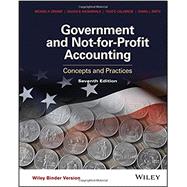This text is an unbound, three hole punched version.
Government and Not-for-Profit Accounting, 7th Edition by Michael Granof, Saleha Khumawala, Thad Calabrese, and Daniel Smith makes students aware of the dynamism of government and not-for-profit accounting and of the intellectual challenges that it presents. Not only does the 7th edition keep students informed of current accounting and reporting standards and practices, but it also ensures that they are aware of the reasons behind them, their strengths and limitations, and possible alternatives.








